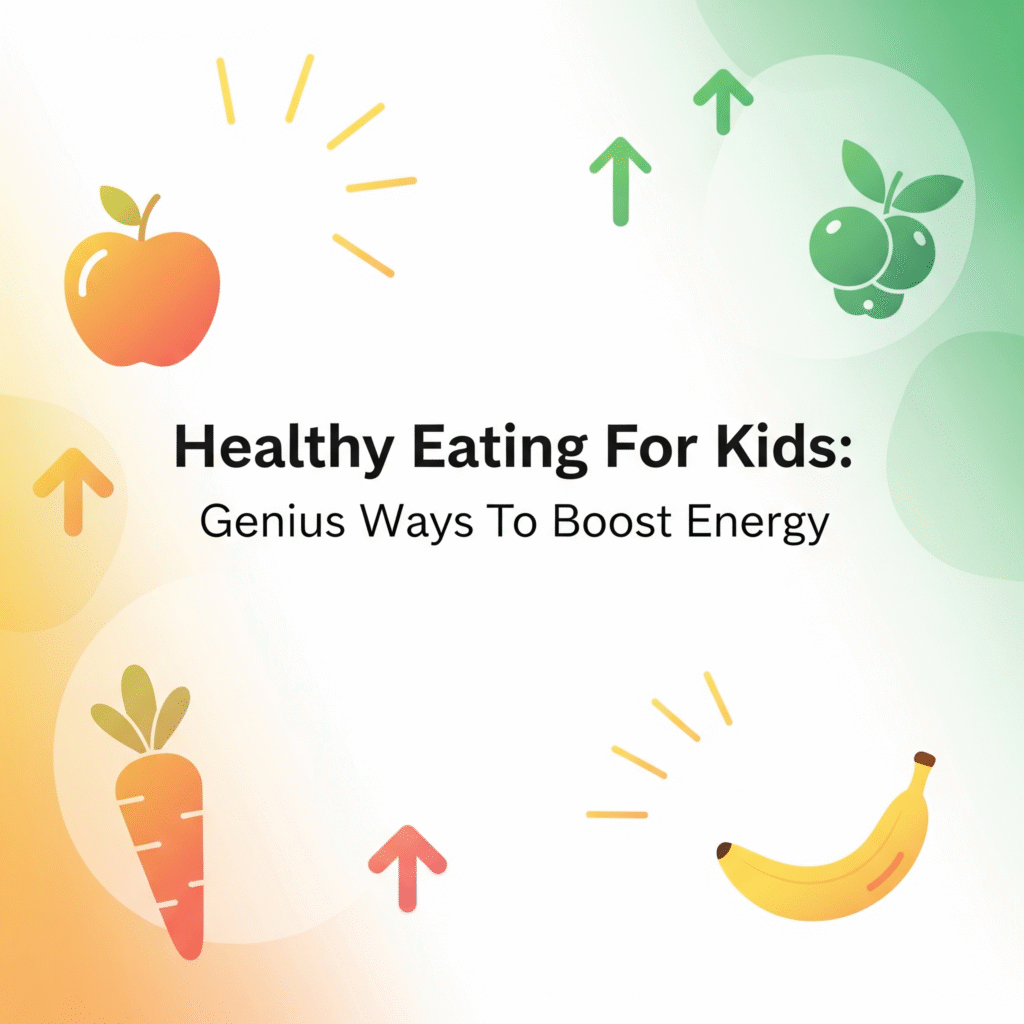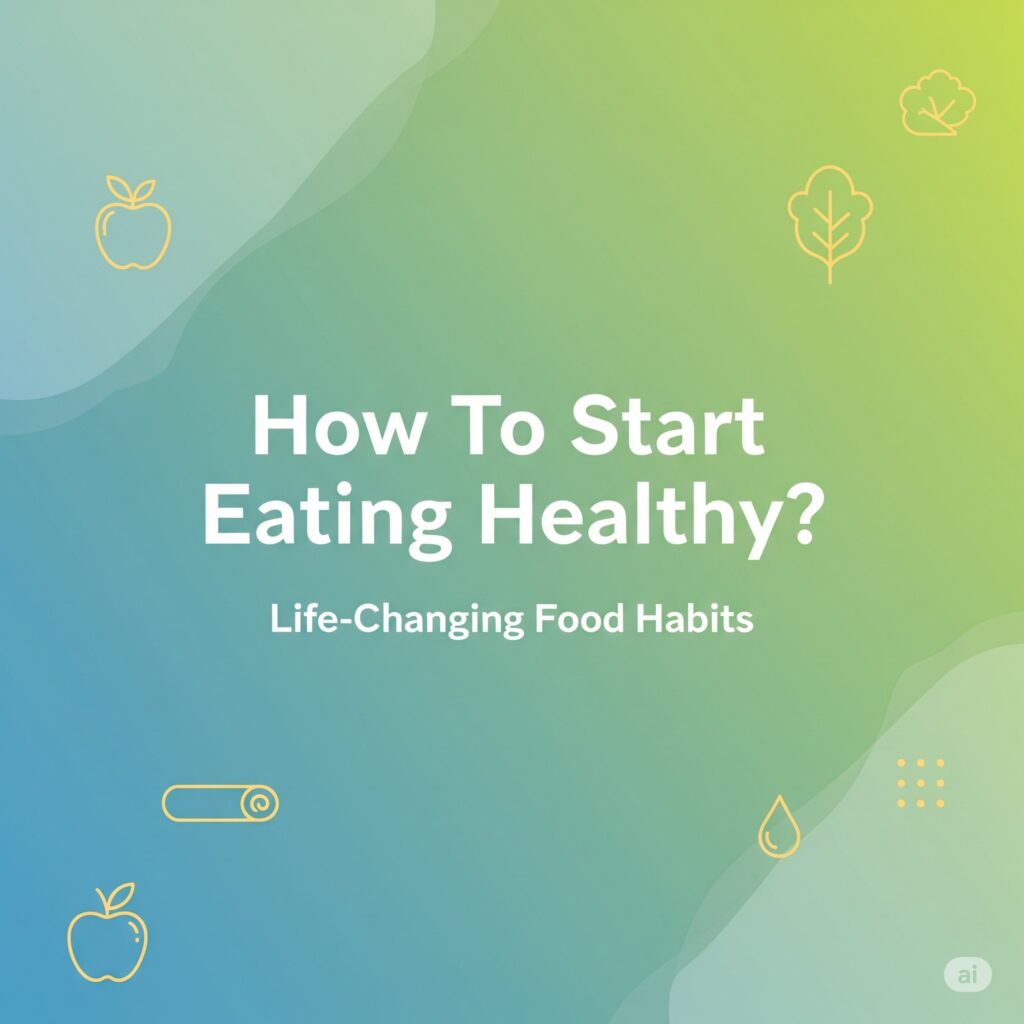Healthy eating for kids doesn’t have to be boring—learn how fun snacks and smart meals can help kids grow strong, stay sharp, and feel great every day.
Healthy eating for kids isn’t just about cutting out sugar or making them eat more veggies. It’s about helping them grow strong, stay active, and feel good every day. Kids need the right balance of nutrients to fuel their minds and bodies—especially when they’re learning, playing, and growing fast.
But let’s be real—getting kids to eat healthy isn’t always easy. Picky eaters, busy schedules, and tempting snacks can make it tough. That’s where smart choices come in. Healthy eating for kids doesn’t have to be boring or complicated. A few fun swaps and simple habits can make a big difference.
This blog is here to guide you. From school lunches to snack ideas, we’ll break down what healthy eating for kids really looks like—and how to make it work in real life.
Table of contents
- How AI meal planning improves healthy eating for kids
- Healthy eating for kids: Snack ideas for school lunchboxes
- Tech tools that support healthy eating for kids
- Healthy eating for kids with nutrition tracking apps
- Using AI to plan healthy eating for kids at home
- Smart kitchen gadgets and healthy eating for kids
- Balanced diet tips that boost healthy eating for kids
- Best AI tools that support healthy eating for kids
- Healthy eating for kids with parental control apps
- How nutrition apps support healthy eating for kids
- AI grocery tools that simplify healthy eating for kids
- FAQ: Healthy eating for kids
- Conclusion
How AI meal planning improves healthy eating for kids
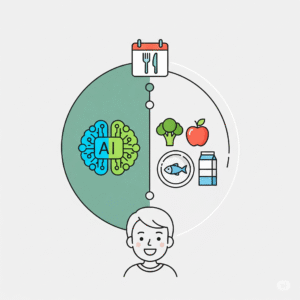
Smarter tools, better meals, happier kids. Keeping kids healthy can feel tough—especially with picky eaters or busy schedules. But thanks to AI meal planning, healthy eating for kids is now easier and more fun. These tools help parents and caregivers create personalized meal plans that actually match their child’s needs, tastes, and health goals.
AI takes the guesswork out of nutrition
AI-powered meal planning apps analyze a child’s age, weight, preferences, allergies, and even activity level. With this info, they suggest balanced meals filled with the right nutrients. This makes healthy eating for kids a lot simpler, especially for families who don’t have time to research nutrition every day.
Easy weekly planning for busy families
Instead of spending hours thinking about what to cook, AI apps like Yummly or Whisk can create full weekly meal plans in seconds. They even make grocery lists and suggest easy-to-follow recipes. This helps parents save time, reduce stress, and stay consistent with healthy eating for kids.
Making meals fun and interactive
Some AI meal tools gamify the experience. Kids can help pick meals, rate dishes, and learn about ingredients through the app. This encourages them to get involved and builds better eating habits. With the right tech, healthy eating for kids becomes something the whole family can enjoy—not just a chore.
AI meal planning is changing how we think about kids’ nutrition. It’s fast, smart, and gives families the tools to raise healthier, happier eaters without the daily stress.
Healthy eating for kids: Snack ideas for school lunchboxes
Tasty, easy, and kid-approved lunchbox options. Packing school lunchboxes can feel like a daily puzzle. You want something healthy, but also fun and easy to eat. That’s where smart snack ideas come in. When done right, snacks can be a powerful way to support healthy eating for kids—even during busy school days.
Go beyond boring sandwiches
Kids often get tired of the same peanut butter sandwich every day. Try mix-and-match options like whole grain wraps with hummus, veggie sticks with cheese cubes, or mini muffins made with bananas and oats. These give variety, taste, and nutrition all in one box.
Add color and crunch
Bright fruits like strawberries, grapes, and orange slices are fun to eat. Add a small container of yogurt for dipping or a handful of crunchy nuts if school allows. These little swaps make lunch exciting and support healthy eating for kids without needing fancy recipes.
Make it easy to eat and enjoy
Bite-sized snacks are winners. Think hard-boiled eggs, rice cakes, or fruit kebabs on toothpicks. You can even prep snack packs using zip bags or reusable containers. That way, mornings are less rushed, and kids still get a lunch that fuels their day.
With smart snack planning, lunchboxes can be both healthy and fun. And when meals are enjoyable, kids are more likely to stick with them—building better habits for life. Little steps like these go a long way in promoting healthy eating for kids every day.
Tech tools that support healthy eating for kids
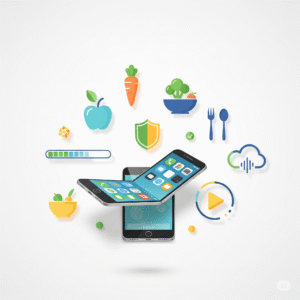
Smart help for making better food choices every day. Technology is changing how families eat—and it’s helping kids stay healthy too. With the right apps and gadgets, even picky eaters can enjoy fun, balanced meals. These tools make it easier to plan, shop, and cook in ways that support healthy eating for kids without making it a chore.
Meal planning apps
Apps like Yummly, Eat This Much, and Mealime are perfect for creating weekly menus. You can add recipes based on nutrition goals and allergies. Some apps even auto-generate grocery lists. These tools save time and reduce food waste while boosting healthy eating for kids. Kids can also explore new meal ideas and help in planning—making them more excited about their food.
Nutrition tracker apps
Apps like MyFitnessPal or MyNetDiary have kid-friendly versions or settings that track calories, vitamins, and more. Parents and older kids can use these to understand what’s going into their bodies. When you can see if you’re getting enough iron, fiber, or calcium, it’s easier to adjust and aim for healthy eating for kids every day.
Smart kitchen gadgets
Tech like smart blenders, air fryers, and digital food scales make cooking healthier and quicker. Some blenders even come with apps to show what smoothie blends are best for energy, digestion, or immunity. These gadgets keep food prep fun and reduce the need for unhealthy shortcuts like fried snacks or sugary treats.
By using these tools, healthy eating becomes easier, more interactive, and even fun. The best part? These small changes build long-term habits that truly support healthy eating for kids—without the usual food fights.
Healthy eating for kids with nutrition tracking apps
Simple apps to keep meals smart and balanced. Keeping track of what kids eat doesn’t have to be stressful. With today’s nutrition tracking apps, you can easily make smart food choices every day. These tools are designed to help you stay on top of nutrients, portion sizes, and even fun food swaps—making healthy eating for kids easier than ever.
MyFitnessPal and Cronometer
Apps like MyFitnessPal and Cronometer let you log meals, check calories, and track vitamins. While they’re often used by adults, teens and older kids can use them too—with a little guidance. These apps show you how different foods affect energy, focus, and even sleep. This keeps healthy eating for kids more balanced and informed, especially during busy school days.
Yazio and Fooducate
If you’re into visuals and daily tips, Yazio and Fooducate offer meal plans and healthier suggestions. They scan barcodes and give real-time feedback on your food picks. This helps make healthy eating for kids more fun and interactive. You’ll even get emoji ratings for snack quality—who doesn’t love that?
Using these tools every day helps build better food habits. Whether you want to prep meals, cut down on sugar, or just stay consistent, nutrition tracking apps are a cool way to support healthy eating for kids in real life.
Using AI to plan healthy eating for kids at home
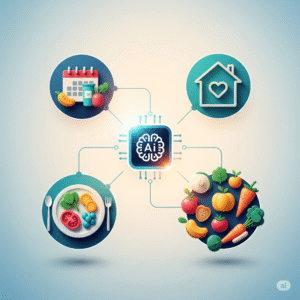
Smart food choices made easy with AI tools. Planning meals for kids can feel tricky, especially when you’re short on time or ideas. But now, AI tools can help you build fun, balanced meals without stress. These tools suggest recipes, shopping lists, and even track portions to support healthy eating for kids at home.
Chatbots for meal planning
AI chatbots like ChatGPT and Mealime help you create weekly meal plans based on your preferences. Just type what ingredients you have or what your kid likes to eat. The chatbot suggests healthy recipes that are quick to make. This makes healthy eating for kids feel less like a chore and more like a game.
Grocery list generators
Some apps use AI to generate smart grocery lists. When you select a meal plan, the app lists everything you need—organized by category. That means no more forgotten veggies or extra junk food. It’s a great way to stay focused on healthy eating for kids every time you shop.
AI tools save time and reduce the guesswork when you’re feeding younger siblings or cousins. You get tasty, balanced meals without needing a nutrition degree. That’s the power of tech helping with healthy eating for kids in your own kitchen.
Smart kitchen gadgets and healthy eating for kids
Make healthy meals faster with cool tech tools. Smart kitchen gadgets make cooking fun, fast, and easier—especially when you’re trying to support healthy eating for kids. These tools help you prep fresh meals at home with less stress. And yes, they’re perfect for students or young adults who help out at home or care about what younger siblings eat.
Air fryers for crispy, healthy snacks
Air fryers are a game-changer. They cook food with little to no oil. You can make homemade fries, chicken nuggets, or even veggie chips that taste great and still support healthy eating for kids. Many air fryers now come with smart settings that auto-adjust time and temperature. Just press a button, and boom—healthy snacks done.
Smart blenders for smoothies and soups Healthy eating for kids
A smart blender can recognize ingredients and adjust blending time. That means fewer chunks and more smooth, tasty results. Use it for fruit smoothies or veggie-packed soups. It’s an easy way to sneak more nutrients into meals, which is key to healthy eating for kids. Some even have apps that track recipes and nutrition info.
Portion scales and smart lunch prep
Smart kitchen scales help measure the right portions. These are helpful when packing school lunches or planning meals. You just place food on the scale, and it shows you how much protein, carbs, or sugar is in it. This makes healthy eating for kids more accurate and fun—especially if you’re trying to learn nutrition basics at home.
With these smart gadgets, eating well doesn’t feel boring or hard. They make cooking cool again and help kids enjoy meals that are both tasty and good for them.
Balanced diet tips that boost healthy eating for kids
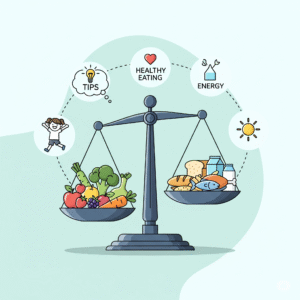
Easy ways to help kids eat better every day. Getting kids to eat balanced meals can feel tricky. But it doesn’t have to be! A balanced diet means giving your body the right mix of nutrients—like protein, carbs, fiber, and healthy fats. For kids, this is super important because their bodies and brains are growing fast.
Include all food groups
A healthy plate should have fruits, veggies, grains, proteins, and dairy. For example, a meal could be grilled chicken, brown rice, and steamed broccoli, with a slice of melon on the side. This kind of variety keeps meals fun and supports healthy eating for kids.
Make snacks work harder
Snacks are a big part of kids’ diets. But instead of cookies or chips, try yogurt with berries or apple slices with peanut butter. These kinds of snacks give energy and help build strong bodies. When smart snacking becomes a habit, it naturally supports healthy eating for kids without feeling like a diet.
Drink water, not sugar
Many kids drink juice or soda, which adds lots of sugar. Water is the best drink. It keeps kids hydrated without extra calories. You can even make it fun by adding fruit slices or using colorful water bottles. Small habits like this go a long way in building routines around healthy eating for kids.
Balanced meals don’t need to be complicated. Just focus on variety, whole foods, and simple swaps that stick. Start with small changes at home, and kids will pick up good habits fast.
Best AI tools that support healthy eating for kids
Smart tech making mealtimes healthier and easier. AI isn’t just for robots and homework helpers. It can actually make eating healthier way easier—especially for kids. From planning balanced meals to tracking nutrition, AI tools are stepping into the kitchen in cool ways.
AI meal planners for families
Tools like Yummly and EatLove help families plan meals based on kids’ age, activity, and food preferences. You just set the goals—like more veggies or less sugar—and the app does the work. These tools also help parents stick to healthy routines without stressing over what to cook next.
They can even suggest grocery lists that include fun but nutritious snacks, which supports healthy eating for kids without making it boring.
Smart recipe apps with kid-friendly filters
Some AI-powered recipe apps come with filters just for kids. For example, SideChef lets users choose kid-safe meals, and it even shows step-by-step images. This makes cooking more fun and gets kids involved in the kitchen. When kids take part, they’re more likely to try healthy foods—like spinach in a smoothie or oats in pancakes.
That’s a great way to turn picky eaters into healthy eaters while sticking to the goal of healthy eating for kids.
AI nutrition trackers built for kids Healthy eating for kids
Apps like MyNetDiary and Snaque track what kids eat and compare it to daily nutrition needs. These apps use AI to spot gaps—like not enough fiber or too much sugar—and give tips to fix them. This helps parents see how their child’s diet lines up with healthy eating goals. Plus, it builds awareness around healthy eating for kids in a way that feels like a game.
AI might not cook dinner (yet), but it can make planning and tracking much easier. If you’re a student with younger siblings or planning to become a parent someday, it’s cool to see how smart tools are already helping shape better food habits.
Healthy eating for kids with parental control apps
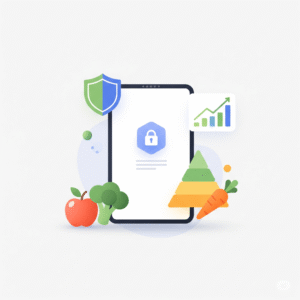
Make better food choices by guiding kids through screen time and snack time. Tech isn’t just about games and YouTube anymore. Parental control apps are now helping families create better eating habits too. These tools can guide kids toward smart screen-time choices—and healthier snack choices.
Set screen time limits for snack routines
Too much screen time often means more junk food. Many parental control apps let you set time limits or schedule breaks. You can use these breaks to introduce healthy snacks or meals. It’s an easy way to add structure and make healthy eating for kids part of their daily routine.
Use app filters to block junk food ads Healthy eating for kids
Some apps can block or filter content. This helps reduce exposure to fast food and sugary snack ads. Fewer ads = less craving. It gives kids space to enjoy better food options. Encouraging healthy eating for kids becomes easier when junk food isn’t flashing in front of them all day.
Track habits and rewards
Apps like Qustodio and Norton Family let parents track device usage and set rewards. You can reward good food choices with screen time points. It’s fun and motivating. Kids feel in control, while still making good decisions. This system supports healthy eating for kids in a way that feels modern and playful.
With a few simple settings, tech can actually help—not hurt—your efforts to build better food habits.
How nutrition apps support healthy eating for kids
Smart apps can make smart food choices easier. Nutrition apps are like pocket-sized food coaches. They’re easy to use and perfect for busy families. These apps help track meals, suggest better food options, and make healthy eating for kids feel like a fun activity instead of a chore.
Food tracking makes choices clearer
Most nutrition apps have simple trackers. Kids or parents can log meals, snacks, and drinks. This helps everyone see what’s being eaten each day. With a quick scan or tap, the app shows if the food is high in sugar, fat, or missing key nutrients. This visual feedback is great for building healthy eating for kids step by step.
Fun features turn learning into a game
Apps like Yummly or Kurbo turn nutrition into a game. Kids can unlock badges, earn points, or get fun reminders about veggies and water. These features keep things light and playful, while still pushing better habits. They support healthy eating for kids without feeling too strict or boring.
Custom tips for picky eaters
Nutrition apps often adjust to food preferences. If a child hates broccoli, the app might suggest carrots or sweet potatoes instead. This flexibility keeps kids interested and makes healthy meals easier to plan. Plus, having a personalized food guide means better results and fewer fights at dinner.
With today’s tech, staying on track with food goals is easier than ever. Nutrition apps are doing more than counting calories—they’re helping kids learn, grow, and enjoy what’s on their plate.
AI grocery tools that simplify healthy eating for kids
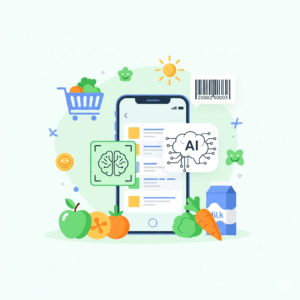
Smarter shopping means smarter meals for little ones. Planning grocery lists can be stressful—especially when trying to choose what’s best for kids. But AI grocery tools make things easier. They help parents pick healthy items, avoid junk food, and stick to better food habits. These tools support healthy eating for kids without the confusion.
Personalized shopping lists for kid-friendly meals
AI tools like Whisk and Basket help create grocery lists based on healthy recipes. You just add your meal plan, and the app gives a list of what to buy. It also suggests swaps if something isn’t available. This keeps shopping simple and focused on healthy eating for kids.
Smart filters help skip junk
Most AI grocery apps come with filters. You can block high-sugar snacks, soda, or anything that doesn’t meet your nutrition goals. That means fewer unhealthy temptations in the cart. These filters are great for families who want to build a home full of good food choices. It’s another win for healthy eating for kids.
Budget-friendly and time-saving
Many AI grocery tools also show cheaper or healthier alternatives. They compare prices, suggest sales, or offer one-click delivery. This saves time and money while still keeping your meals nutritious. That’s super helpful when you’re busy but still want kids to eat well.
These smart tools make grocery shopping easier, faster, and healthier. They take the guesswork out of buying food and keep your focus where it matters—building strong, healthy habits for kids.
FAQ: Healthy eating for kids
What are the best foods for kids to eat every day?
Kids should eat fruits, vegetables, whole grains, and proteins like eggs, fish, or beans every day. These foods help them grow strong and stay full of energy. Healthy snacks like yogurt or nuts are good too.
How do I get picky eaters to try new foods? Healthy eating for kids
Start with small bites. Mix new foods with something they already like. You can also make meals fun—use shapes or colors. Keep offering the food without pressure. Over time, they might give it a try.
Can kids eat fast food sometimes?
Yes, but not too often. It’s okay to enjoy fast food once in a while, just not every week. Try to balance it with home-cooked meals. Healthy eating for kids means more fresh food and fewer fried items.
How much sugar is okay for kids?
Kids should eat as little added sugar as possible. That means cutting down on candy, soda, and sugary cereal. Read food labels. Try to choose snacks with natural sugars like fruit instead.
What drinks are best for kids?
Water is the best. Milk is also good for strong bones. Avoid giving too much juice or soda. Too many sugary drinks make kids feel tired and can lead to weight problems.
Why is healthy eating important for school performance?
Good food helps kids focus better. It improves memory and keeps energy up during the day. Healthy eating for kids can even boost mood and help them feel more confident in class.
Conclusion
Healthy eating for kids doesn’t have to be hard. It just takes small steps and smart choices. The goal is to build habits that last. Kids need foods that help them grow, stay active, and feel good. That means more fruits, veggies, and whole foods every day. Less sugar and junk food make a big difference.
Healthy eating for kids also means learning what’s good and why it matters. When kids understand food, they make better choices on their own. Every snack, lunch, or dinner is a chance to eat better. Healthy eating for kids is about balance, not being perfect. It’s okay to have treats sometimes—just not all the time.
Parents, teachers, and even older siblings can help. When everyone sets a good example, it’s easier for kids to follow along. That’s how healthy eating for kids becomes a natural part of life. Start small, keep it simple—and help make healthy food the fun and easy choice.

